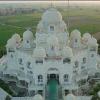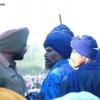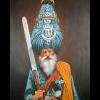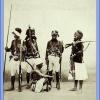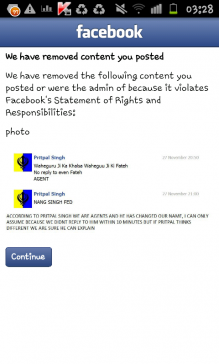Leaderboard
Popular Content
Showing content with the highest reputation on 12/04/2012 in all areas
-
WLS, What you have done is to present the experience of your family in 1947 with regard to the massacre of Muslims in Doaba as the experience of the entire Sikh community. This is similar to how Khushwant Singh has presented the Hindu-Sikh intermarriages that occurred in his family pre-1947 as the normative experience of the whole Sikh community. There is no doubt massacres of Muslims took place in East Punjab committed by Sikhs and the contemporary witnesses note the particular ferocity of these acts of violence. You appear to want the whole Panth to beat themselves over the actions of that generation without placing their actions in perspective. Note the background at the time the violence took place. 1. 40% of the community had suddenly become refugees, and moved to an area over which they still did not have political control. 2. If we accept that about one million were killed, 500,000 Muslims, 250,000 Sikhs and 250,000 Hindus. This meant that even though a lower number of Sikhs had died than Muslims, in terms of percentage 4.5% of Sikh population had been killed compared to 2.5% of Muslims and 2.6% of Hindus. For a small community losing such numbers would have been devastating. 3. There was a belief that the Muslims would choose to stay in East Punjab and the Sikh population numbers would be diluted and they would not be a majority in any of the East Punjab districts. Not only would the Muslims were staying put but they were also attacking Sikh refugees in areas where they should have been safe (East Punjab). The cities of Jalandhar as well as Ludhiana were being used as bases to attack neighbouring Sikh villages similar to the way the Bosnian Muslim enclave of Srebenica was used to attack Serb villages. 4. The Sikh Jathas replicated the exact same violence on the Muslims of East Punjab that the Muslims had visited on the Sikhs of Hazara in 1946. The Muslim leadership believed that the Sikhs had lost their martial nature due to decades of economic success they had enjoyed. In essence the Muslim league plan in Punjab was to use violence in Hazara to beat the rest of the Punjab's Sikhs into submission. As they Sikhs did not retaliate after Hazara this convinced the Muslim league that their plan had worked. This is why the violence after partition in East Punjab came as such a shock to the Muslim league. This is the reason that the Pakistani representative at the UN wanted a resolution passed blaming the Sikhs for the violence!2 points
-
Exactly. The title is meant to be inflammatory so people who look for fights come in here and slap themselves on the face.2 points
-
My family is really messy and stuff and its always me cleaning up after them. When I ask my sister or so if she could clear her mess she says ''if you are so concerned, why don't you go do it'' its the same with my parents. I have to tidy all the rooms in the house otherwise it would be a complete pigsty. My dad praises me for doing this but he doesn't ever at least do his bed or move his chapla outside. Don't even get me started on my sister... How can I get them to at least do their beds? Our house is a tip and it looks horrible. I am also a guy is this weird for a guy to be clean??1 point
-
1 point
-
Nope, no conflict here, just two Gurmukhs/GurSikhs who have nothing but respect for one another. This picture to me is a reminder of how there are people now a days who are trying to change Sikh history and are creating issues in hopes to split the Khalsa Panth into sects. Let this be a reminder to all the youth who who are introduced to Sikhi via a person along with their personal beliefs. Sikhi isn't about which rehit you follow or what jatha you belong to, but what speaks to your soul and what helps you elevate yourself closer to the Guru. Learn to live and let live and avoid stereotyping someone based on jatha. A lot of hate being seen as of late and this picture really made me happy.1 point
-
You can get many alcohol free perfumes, especially Indian ones, some do smell strong though. I was just discussing a few days back about the smell in the Divaan Hall at my local Gurdwara, normally kinda neutral, can always smell the Karah Prashad but i no longer smell the dhoop/aggarbatti. They stopped using it because the smoke irritates the throat of the Granthis and Kirtanias. I personally can't get enough of the stuff. Having that kinda smell in the air creates an atmosphere, it makes me feel devotional. The smell of rose water goes too quickly. Oh and the silver vase like bottle is called a “gulab daani”1 point
-
Boht boht thank you tuhada! :D loll baas sabb teek tak! Tusi kidha jio, tere pichhe kinne sare lok ah forum te?!1 point
-
Good to see you back doaba bhaji...kidda tuhadi jalandhar wali kotti ki haal chaal? .!!!!!! :D1 point
-
1 point
-
Don't wait, you are never young or old to take Amrit. We live in the western world where so many people put stress on how old the body is and then judge if the person has spiritual wisdom. The west waits till school teachers start teaching them education and then in return they term this as spiritual wisdom. But spiritual wisdom does not come with age or by secular school teachers. Spiritual wisdom comes with reading and understanding Gurbani and then applying the Gurbani in our daily life. I don't know how much Gurbani you understand in Gurmukhi, but also start reading the english translations of Gurbani. I say take Amrit as Guru sahib will do kirpa on you. But if you stop reading Gurbani, stop understanding Gurbani, then you may change into a different person. If you keep reading Gurbani and trying to understand Gurbani deeper after taking Amrit then you will change, but only change for the better and change into what Guru Sahib wants you to be. Sikhs that state i want to be a Brahmgyani before taking Amrit have not understood what SatGur Parsad means. They still got their patient clothes on and are standing outside of the surgery room, doubting if the doctor knows what he is doing.1 point
-
Set up a foundation to study historic Punjabi architecture. Make sure all Gurudwaras that are built follow the styles of pre-1849.1 point
-
Just saw that episode 11 of homeland is called 'The M*therf**ker with a Turban' What the hell is this crap ?1 point
-
Just because someone has a turban doesnt mean they arent a m*th*rf*ck*r. Considering how prevalent antibrown attitudes are in the West it's a bit weird how Sikhs only get upset when it becomes overt where as most of the time they sit back and ignore it.1 point
-
for me, santhiya and learning arth of gurbani are essential to maximum anand from gurbani.1 point
-
Always respect your parents. Avoid conflicts of interest by talking more. Read the saki of Guru Nanak and Sacha Sauda.1 point
-
It's a motion to call the riots genocide. Officially. Trust me, this has a big effect. Turkey recently got real mad at France because they recognized the Armenian genocide which Turkey denies happened.1 point
-
Rose water sounds a lot less intense. Some people are allergic to perfumes (including myself) and really distract you from concentrating on Gurbani/meditation.1 point
-
At nanaksar every poranmaschi close to end, singhs go around spraying rose petals water on dhan dhan dhan sri guru granth sahib maharaj first then rest of the sangat..!!1 point
-
1 point
-
My friend tried to get me off drinking soda. Each time he'd see me holding a can, he'd say "oh leh, tu fer ghode da pishaab peen lappeya?" And I'd be like WTH man! He'd say "oye tenu nai pata? ihde ch ghode da pishaab hunda!"1 point
-
awww dont cry, i think u are doing gr8 at ur age, gettin up so early to do paat n simran. You are so disciplined at a young age, I'd love to have a son like u that is soo disciplined and into his faith. You seem passionate about Sikhi, thats soo lovely. Not sure why ur mother is thinking the way she is, there are lots of Sikhs with turbans n beards that have gr8 jobs. Whatever happens in life in the hands of God, whether they are turbaned or not. There is no need for u to cry, be strong ur doing gr8. I agree that its not easy to take Amrit with the original poster, and need to be prepared for it, but I personally feel being passionate about taking it at ur age is good, as there are many people who wished they had the chance when younger, such a gr8 age to be on the right path, rather than get diverted the wrong way, where later on u may do by mixing with wrong company. Hope all goes well with you, dont stress about it, and hope Waheguru keeps u and ur family happy.1 point
-
1 point
-
1 point
-
Another example just look at the struggle of Tibetan Buddhist. Buddhist are well aware of the fact that radical hindus destroyed buddhism hertiage/culture in india, killed them and kicked them out, but despite of all of that- Tibetan spiritual leader - Dalai lama uses India against China. Both parties use each other, india uses dalai lama as a token against china, dalai lama uses india as platform against China...its strategic proxy war..!! If Sikhs need to get anywhere with their sovereignty and fight against human rights and fight against congress, they need to have endorsement from powerful figures(does not have to leader could be actor like george colloney/amir khan) and yes, even if that powerful figure is a scum bag/corrupt leader - that is sour truth and reality of the world...get on with it with chankya type politics or off course we can all do bhagti and wait for one day- shaheed singhs transcedent and make khalsa raj ( which i have no doubts they will as its rightly predicted) but for time being -either get in the mud as painful it may sounds/appear and try to make a difference play this game of politics, if not just stay away from all this dirty politics all together..stick with youtube politiical activism..its good atleast making some difference..!!1 point
-
1 point
-
Nidar was allowed a few weeks grace to find alternative premises, which i think is a kind gesture from the gurdwara committee. I dont see why we cannot act civilised even though we disagree with them. This campaign is about informing people, and giving them a balanced view, nidar and his students are free to also present their views. Mostly all the nihangs and parchaaraks and committees i have talked to have given me the same feedback - They do not agree with Nidar's view of there being a Hindu-Sikh, the elders who we have spoken to have taken everything on board and will be continuing this on a organisational level. There is no need for anyone to get involved in any violence or arguments, The gurdwaras are listening slowly and they have teh authority to act. what you can all do to help is raise awareness within your peers, families and speak to your elders and gurdwara sevadaars and make sure most of the sangat is aware of nidar and his views. you can read the articles do your own research and then go and teach others, so when they are questioned by NIdars students they have the answers they need there will be others amongst your friends who still will not fully accept that Nidars lineage and claims are fake, but do not talk harshly to them, allow them to have their view. he has managed to convince his students that the letter from nihang dals is a fake - i would say to them please contact the individuals yourself, don't take his word for it, you have nothing to lose by seeking the truth. again i wish all of his students well and hope they can find it within themselves to question things and make their own mind up and not just follow the crowd they are in, abandon alcohol and marijuana abuse and go back to being Gursikhs and doing paath and simran. Wjkkwjkfateh1 point
-
I'm not sure how much of an awkward question this is for you, but I hate this question. Whenever I see relatives or close family friends who I haven't seen in quite some time (years), most of them ask in kind of a cheeky/random manner in the middle of a very normal discussion "achaaa fir tu paath vi karda hunda" *big smile on their face* and I'm like, is this a trick question? I feel like if I say yes, i will sound like I'm giving off the false impression that I do a lot of path and if I say no I feel like that would be lying. I usually end up saying hanjee thorda jeha karlaida lol. What are your responses when someone asks you such a question? I ask because a lot of punjabi people tend to judge a person based on how you carry yourself, i've been more and more aware of my surroundings and micro-expressions so I was wondering what sangat thought about this subject?1 point
-
1 point
-
In memory of Sikh Warriors - Past and Present. http://www.facebook.com/ElusiveFighter1 point
-
Waheguru Ji Ka Khalsa, Waheguru Ji Ki Fateh, This mighty not be what u asked for but it's definitely inspiring. Bibi Rena Kaur was a young Gursikh in BC who in Guru Sahib's hukam passed away on May 8th, 2004, along with Bhai Parminder Singh Ji and Bhai Charanjit Singh Ji in a car accident. She was an inspiring young kaur and a role model to many. She was a beloved Gursikh youth leader/sevadaar, talented keertani, and shastar vidya student, who inspired the creation of Kaurs United. Rena Kaur was born on March 21, 1987 in Surrey, BC and as a child she attended Khalsa School, followed by Beaver Creek Elementary school and eventually Tamanawis Secondary School. She left this earth on May 8, 2004 at the physical age of 17, at which time she was a grade 11 student, a volunteer at the Guru Nanak Academy, a member of the Shaheed Baba Deep Singh Gatka Akhara, an amazing keertani, a friend, a sister, and a daughter. Most obviously, she was and still is, an inspiration to us all. In her younger years at Khalsa School, Rena Kaur learned keertan from Bhai Tejinderpal Singh “Dulla” jee and had been blessed by the Guru with a voice and a style of keertan that was unique and inspiring. Her fingers fluttered on the vaja like a butterfly – as if it was so easy to her; but when teaching keertan to others, she would do it with so much sehaj, love, humility, and understanding. What set her apart from other keertaniya is that not only did she have “skills” – but she also had genuine love and pure faith. When she did keertan, the message of the shabads also vibrated in her heart. Rena Kaur had done Gurbani Santhiya while studying at Khalsa School. From her notes, we have been able to find out that she had done full santhiya of Guru Granth Sahib ji and learned many shabads in keertan extensively. Thus, her Gurbani vidya was also impressive for a person of that young an age. It’s unfortunate for us, but also the Guru’s hukam, that the most amazing and intense times Rena Kaur did keertan were not recorded, because they took place during regular local Sangat programs where there is no recording done. I recall, however, several times, when she would be doing keertan in local Sangat, and nearly everybody in the darbar was still and silent, with their eyes closed, meditating as if they had somehow been overcome by the combination of the Bani, her voice, the sound-currents, and just the moment in itself. Some gurmukhs in Sangat have also recollected some experiences of divine visits, or darshan, of souls of Shaheeds (martyrs) from sach khand (realm of truth) that came into the darbar during Rena Kaur’s Kirtan or even sang through her. Only the Guru knows the limits of the Guru’s wonders. There is one incident that shows Rena Kaur’s spirit of unwavering courage and confidence that came out as she became more dedicated to the gatka akhara. Rena Kaur was walking home from Gatka class (her house was 5 to 10 minutes walking distance from the place where we had Gatka classes) and it was late evening, practically nighttime. The sky and surroundings were really dark, and she was walking alone, but I remember her saying she didn’t feel afraid. As she told me afterwards, from the distance she had seen a man walking towards her, but couldn’t see his face. He walked closer, and she continued to walk, with her head held high, and she put her hand on her kirpaan. As he was coming closer to her, she knew he had bad intentions. He was some strange guy and she got really bad vibes from him. She had a feeling he was going to try do something to her. Only a Guru’s Khalsa could do what she did in this situation… The man came near her and as he was about to come up and grab her, she drew out her kirpaan, grabbed the man by his neck, put him in a head lock, made him fall to the ground, and had one arm around his neck, while her other hand held the kirpaan up to his head. I can imagine the amazing levels of bir-rus that must have been pouring out of her, and she yelled at him, saying that if he touched Guru Gobind Singh Jee’s daughter, he would get hurt. When looking at that situation, we need to realize that Rena Kaur’s height was only 5’3″, and this man was much taller by comparison. This is the power that Guru Gobind Singh Ji’s daughters have. The man got so scared he started panting and he said, “Whoa whoa! Okay take it easy,” and he ran away from her. There were so many situations like this where Rena Kaur proved herself to be a real Khalsa. Before doing Gatka at performances, her and Navneet Kaur used to sing this kavita that Ustaad Charanjit Singh wrote for them. I remember the LOVE and PRIDE in Rena Kaur’s voice when she would recite the kavita, “dheea asee Dasmesh diya, Bhago diyaa bhaina!” (meaning “We are the daughters of Dasmesh (Guru Gobind Singh Ji), and the sisters of Mai Bhago.”) She loved the kavita so much that she would recite it to me over the phone. At the funeral in May of 2005, there was an older woman who approached me and said, “it’s amazing, you know… Rena Kaur accomplished more in her short 17 years of life, than I could ever accomplish if I lived forever.” I realized, this may be true for many of us. Everywhere Rena Kaur went, she spread chardi kalaa (high spirits). The more she was introduced to different Panthic groups, the more she spread her light of love to this world. Rena Kaur slowly became more and more strict on her path with Sikhi, and she followed rehat with full pride, vigour, respect, courage, and humility. Through growing up in saadh sangat and attending countless smagams throughout her life, she learned a lot about the importance of living in the moment, giving love to all of humankind, and putting Guru Sahib jee above everything. A concept she would always reiterate to me was that we only live for one breath; “ek dhum.” The breath you just breathed, she would say, is gone. You’re inhaling right now, but the NEXT breath is not promised, therefore you’re only truly living for one breath, as a guest in this temporary world. Rena Kaur truly lived her life in this way, knowing that nothing but death is certain, and that death is the constant companion of a Khalsa (“mardee ang ban ke jiondee sang ban ke”). Rena Kaur would speak about leaving this world as if it was natural to her, and she had no fear about it. She actually spoke about her willingness to live in Guru Sahib jee’s hukam and the importance of accepting of the Will of God and keeping strong and happy throughout life’s difficulties, which she not only preached, but practiced as well. I wont forget how she once told me, with a huge smile on her face, “sometimes I feel like I won’t be staying in this world too long… but at my funeral, I want there to be keertan going on, I want everyone to be in total chardee kala!! Make sure everyone’s smiling, okay?” The real lessons that Rena Kaur instilled in us were how to live in the spirit of humility, in high spirits, and with a positive outlook on life. She taught us to balance our lives by seeing our priorities on the weigh-scale of Gurmat, rather than worldly thoughts. She taught us to recognize the importance of innocent love or bhola bhaao, rather than using our worldly cleverness. Most of all, I think she lived up to her name and taught us its value as well. She was a Kaur, a child of the Guru, and she became the Rena (dust) of the sangat’s feet, and left us with lessons on how to do the same. I’m so happy that she’s gone back home, where Guru Jee is waiting for the rest of us, IF we follow and learn from the dreams and the legacies that Bibi Rena Kaur Ji, Bhai Charnjit Singh Ji, and Bhai Parminder Singh Ji left behind.1 point
-
Well done analysis of the beginnings of the Sikh/Punjabi struggle under the Indian state. Taken From: http://sikhwithit.bl...discontent.html Seeds of Discontent Originally published in "Dedicated to the Sikh Struggle" Despite attempts to do so, the events before and after the 1984 Sikh genocide cannot be examined in isolation of their broader political context. Broken promises, the demand for greater Sikh sovereignty, covert intelligence operations, the state of emergency, and human rights abuses must all be accounted for in order to create an accurate reconstruction of the time period. The seeds of discontent in the Punjab region were sown decades before the explosion of violence in Punjab, in the streets of Delhi and other cities across India in the 1980s. The calls for communal sovereignty and provincial autonomy did not arise spontaneously. They were the manifestation of discontent with a post-independence reality unreflective of its roots. The imposition of emergency rule in the 1970s inflamed tensions and the crackdown in Punjab would lead to the creation of an untenable political circumstance. Broken Promises: The roots of discontent amongst the Sikh community, although plentiful and diverse, can be to a large extent traced back to pre-1947 commitments made by the Congress party. Two main points of displeasure amongst the Sikh community following India’s independence were that the Congress party had abandoned its pre-independence commitment to the reorganization of states based on linguistic homogeneity with regards to Punjab and the broader concept of provincial autonomy. The following excerpt helps to provide context into the position of the Congress party leadership with regards to provincial autonomy and linguistic homogeneity: “On 10 August 1928, the Nehru committee submitted its report on the future of the Constitution of India. Apart from reiterating the principles of provincial autonomy and reorganization of the states on the basis of linguistic homogeneity, the report also confirmed the reservation of seats in the Legislative Assemblies in the Provinces as well as at the Centre for Muslims of India in proportion to their population in the provinces. However, the report denied similar reservation to other religious minorities and went on to state categorically that there should be no reservation of seats for any community in the Punjab and Bengal. Following the publication of the Nehru report, Sikh leaders expressed anxiety over their future in India under a nationalist government which provided no statutory protection for them as a minority. To allay their fears the Congress Party organized its annual session of 1929 at Lahore and passed a resolution saying that on achieving independence no Constitution would be framed unless it was acceptable to Sikhs.” (Kumar: 120). The Congress report of 1928 is a pivotal document as it formed the basis of what the future state of India’s framework would consist of. It provided a blueprint from which those involved in the independence discussions could base their decisions with regards to accession and secession. As the Congress party moved further and further away from this declaration with regards to Punjab, the angst amongst India’s Sikh community would continue to grow. This is not to say that every Sikh in every corner of India was enraged, no community is so homogenous that it acts and thinks in perfect unison. However, the protests, political movements, and resistance prevalent amongst the Sikhs of Punjab in the decades following independence are telling. The population was not asking for the Central government to kneel, rather that the Congress party uphold its commitments. The excerpt discussed above is not unique in nature and Congress leaders would on multiple occasions re-affirm the party’s commitment to guaranteeing that no constitution would be passed if unacceptable to the Sikhs of India. In response to a question from Madhusudan Singh on what guarantees Gandhi could give with regards to the resolution passed by his party at Lahore in 1929, he responded “I ask you to accept my word and the resolution of the Congress that it will not betray a single individual much less a community. Let God be the witness of the bond that binds me and the Congress with you” (Kumar: 122). As he was further pressed on this issue “Gandhi said that the Sikhs would be justified in drawing their swords out of the scabbards as Guru Gobind Singh had asked them to, if it would recoil from its commitments” (Kumar:122). In 1950, when the Constitution Act of India was enacted (devoid of special protection for the Sikhs), representatives from the Akali Dal party declared in the constituent assembly “the Sikhs do not accept this Constitution: the Sikhs reject this Constitution Act” (Singh: 245). Yet, in direct opposition to their previous commitments, the Congress party would indeed pass a constitution not accepted by the Sikhs. Broken commitments such as the ones discussed above would help form the foundation of the Punjabi Suba movement, which rose to prominence post-1947. The Sikh community and its leadership would advocate for the greater autonomy and freedom that the Congress party had promised to it. The creation of a state of Punjab based on linguistic homogeny and the control of waterways (which were of particular importance given the agrarian nature of Punjab) were of particularly heated contestation. Rise of the Punjabi Suba movement Historically the Sikh community has viewed the Punjab region as its homeland due to its status as the birthplace of Sikhism and the fact that it is home to a majority of the Sikh community and many of the faith’s most revered sites; as such one cannot simply separate the reorganization of Punjab and Sikh discontent into two mutually exclusive entities. The Akali Dal and its leader Master Tara Singh would continue to advocate for a Punjabi speaking state (Lal: 55). The composition of this state would have been in line with the commitment to linguistic reorganization as per the Congress’ pre-independence doctrine. However, this commitment to linguistic reorganization was abandoned shortly after Indian independence upon the recommendations of the Linguistics Provinces Commission. In the eyes of the commission: “It (i.e. the formation of linguistic states) would unmistakingly retard the process of consolidation of our gains, dislocate our administrative economic and financial structure, let loose, while we are still in a formative states, forces of disruption and disintegration and seriously interfere with the progressive solution of our political and economic difficulties.” (Kumar: 177). In essence, the promise of linguistic reorganization in the case of Punjab had become a source of inconvenience for the Congress party and their new partitioned India. In the words of Nehru as he spoke to Master Tara Singh in 1954 who reminded him of the Congress’ commitments to the Sikhs, “the circumstances have now changed”. (Singh: 245) As the Akali Dal continued their campaign for a Punjabi speaking state, Hindu organizations had begun advocating that the community formally disown the Punjabi language in favour of Hindi (Kumar: 177). This act of collusion would further inflame the political unrest caused by the Congress’ unwillingness to abide by its 1928 resolution. As constitutional autonomy continued to elude the Sikh community, Sardar Kapur Singh would have this to say on September 5th, 1966 as he stood up to vote against the bill for the reorganization of the state of Punjab: “Madam Chairman, I have gone through this draft Bill most carefully and I have heard the Honourable Home Minister with the diligence and respect which his speeches and utterances always deserve. Madam Chairman, as it is, I have no option but to oppose this Bill. Like the curate’s egg, though it might be good in parts, it is a rotten egg. It might be edible, but only as a measure of courtesy, as it is devoid of nutritional qualities and since its putrefaction is far gone, it is really unfit for human consumption” (Singh: 239). The bill for the reorganization of the state of the Punjab would fail the test for the Akali Dal party as well. On July 20th 1966 Resolution 2 of the Working Committee of the Shiromani Akali Dal was passed: “SIKHS RESOLVE AND PROCLAIM their determination to resist, through all legitimate means, all such attempts to devalue and liquidate the Sikh people in a free India, and consequently, DEMAND that the following steps should be taken forthwith by the rulers of India to assure and enable the Sikhs to live as respectable and equal citizens of the Union of India, namely, FIRST the Sikh areas deliberately and intentionally cut off and not included in the new Punjab to be set up namely, the area of Gurdaspur District including Dalhousie, Ambala District including Chandigarh, Pinjore, Kalka, and Ambala Saddar, the entire Una Tehsil of Hoshiarpur District, the areas of Nalagarh, called Desh, the Tehsil of Sirsa, the sub-Tehsils of Tohana and Guhla, and Rattia Block, of contiguous portion of the Ganganagar District of Rajasthan must now be immediately included in the new proposed Punjab so as to bring all contiguous Sikh areas into an administrative unit, to be the Sikh Homeland, within the Union of India. And SECOND, such a new Punjab should be granted an autonomous constitutional status on the analogy of the status of Jammu and Kashmir as was envisaged in the Constitution Act of India in the year 1950” (Singh:1948). The resolution does not call for unique wide ranging powers, rather it points to the “autonomous constitutional status” of Jammu and Kashmir as encapsulated in the Constitution Act of India. As this set-up was achievable to the north of Punjab, why could it not be feasible for Punjab itself? The powers requested would have been relatively analogous to that which already existed for other states in India. The resolution was focused on creating a place for Sikhs in India, who had decades prior chose accession over secession. Additionally, this Sikh homeland was to be an administrative unit within the “Union of India”. The focus here was to create an autonomous Sikh land of freedom in the north of India, a notion Nehru had decades prior accepted. In July 1946 Nehru would be quoted as saying “The brave Sikhs of the Punjab are entitled to special consideration. I see nothing wrong in an area and a set-up in the North wherein the Sikhs can also experience the glow of freedom” (Singh: 242). Yet, when the time had come for these commitments to be put into action, they had been forgotten; as resistance to this autonomous state was evident even before Resolution 2 of the Akali Dal working committee and the 1966 statements of Sardar Kapur Singh. Jawaharlal Nehru would go so far as to “tell a correspondent of the Times of London that he would not concede a Punjabi speaking state even if he had to face a civil war” (Kumar: 182). This statement was made following the release of Master Tara Singh who had been jailed preemptively following his vow to fast until death in demand of a Punjabi Suba (state). In 1960, “newspapers were prohibited from publishing news regarding the Sikh agitation. Raising slogans for a Punjabi Suba were made illegal” (Kumar: 182). The repression of discontent and freedom of speech in response to the Punjabi Suba movement would become a reoccurring theme in the Central governments dealings with the Sikh community. As opposed to reaffirming their pre-independence assurances, the Indian government would instead meet peaceful assembly with repression, calls for justice with an iron fist, and freedom movements with oppression. An interesting line for the descendents of a movement whose chief figure head (Mahatma Gandhi) would be defined in the Indian history books by his approach of non violent protests, calls for universal justice, and slogans for a free and independent India. State of Emergency: When Indira Gandhi instituted a State of Emergency, all corners of the nation were covered by the cloud of undemocratic rule. This State of Emergency was born not out of a deep concern for the nation, but out of personal survival: “ The declaration of the state of emergency by Prime Minister Indira Gandhi on the night of June 25-26, 1975, to save herself from the aftereffects of Allahabad High Court Judgement unseating her for corrupt practices, as laid down by herself, shook the very foundations of the democratic spirit underlying the Constitution. Armed with the draconian powers including rigorous press censorship, it ushered an era of arbitrariness and arrogance for personal survival and family aggrandizement, with new upstart Sanjay Gandhi and his goons creating terror and wreaking havoc with the system” (Singh 2: 311). The Shiromani Akali Dal would be the only party to take up the cause of opposing Gandhi and her emergency rule. Figures from Amnesty International state that 140,000 people would be detained during emergency, 60,000 of them Sikh. Emergency may not have been declared against the Sikhs, but the resistance to it had a strong Sikh component (Singh 2: 311). As Sikh resistance to Emergency rule grew, in the words of Sangat Singh “Indira got into her head that it were only the Sikhs who constituted a threat to her imperious and dynastic rule, and decided to inflict blows from which they will take long, if at all, to recover” (Singh 2: 312). In 1976, using section 78 of the Punjab Reorganization act Indira Gandhi would allocate the hydel power and waters of the Punjab rivers to Rajhastan, Haryana, Delhi, and Punjab. The Gandhi government would now “award over 75 percent of waters to neighboring non-riparian states and create in them vested interest to the detriment of legal rights in Punjab” (Singh 2: 312). This diversion of water would have devastating effects on the Sikh peasantry, a segment of the population who formed the Akali Dal’s mainstay. Sikhs would also be targeted in the military ranks, as the Defence Ministry would for the first time issue recruitment quotas based on population. The institution of this move would curtail the intake to and composition of Sikh soldiers in the Indian army to just two percent, in line with their proportion of the Indian population as a whole. (Singh 2: 312). The treatment of Sikhs during the 1982 Asian games provides a piercing example of the degree to which Sikhs had been targeted during the emergency period. Haryana’s Chief Minister had instructed the police to cut off all Akali’s entering the state. The following is the account of prominent Indian journalist and author Kuldeep Nayar: “Since the police had no way to differentiated a Sikh who is a terrorist and one who is not, every Sikh travelling to Delhi was searched. Trains were stopped at wayside stations at midnight in cold December and the Sikh passengers were made to get down to appear before a police official on the platform. Buses were detained to get Sikh passengers down and at some places the rustic policemen said ‘All Sikhs should come down’. People travelling in cars were no exception. Many senior retired military officers were stopped and among them were Air Chief Minister Marshal Arjun Singh and Lt. General Jagjit Singh Arora; their disclosure of identity did no matter; luggage in every car was thoroughly searched. Maj. General Shabeg Singh, who later joined hands with Bhindranwale, had gone on record as saying that after the humiliation meted him in Haryana, he decided to join Bhindranwale. Even Swaran Singh (a cabinet colleague of J.L.Nehru who had served India well for many tenures as its Foreign Minister) was stopped and searched despite telling the police who he was. Congress(I) Sikh MPs were no spared and Amarjit Kaur Congress MP, was in tear when she narrated in the Central Hall of Parliament how she and her husband were treated by the Haryana police…. The Sikhs felt humiliated because the Hindus crossing into Delhi from Haryana were not touched, even for the sake of form. The government expressed no regrets and no statement came from any ruling party members that what had happened was reprehensible. Very few Hindus spoke against his. Newspapers also did not report any incident lest it should add to communal tension. The Sikhs felt the government was now against them as a community” (Kumar: 260). The relationship between the Sikh community and India’s governmental bodies had degraded considerably by the 1982 Asian games incident, and yet the worst backlash against the Sikh community was yet to come. As mentioned at the onset of this piece, the events before and after the 1984 Sikh genocide cannot be examined in isolation of their broader political context. The examples and chronology of events above are testaments to this. The untenable situation of the 1980s was not an overnight development. Rather, it had built up over decades and decades, slowly reaching the human rights atrocities of 1984. As the streets of Delhi were filled with burning Sikh corpses and dismembered youth, historical context disappeared from the political discourse. Sikhs were terrorists and a threat to India, no shades of grey existed. The decades of peaceful demonstration and political movements were forgotten, for there was no place for these trivial memories. The here and now was all that mattered, an enemy had been constructed and how its existence was constructed was not up for debate. As we delve into the atrocities of 1984, it is pivotal that we realize that this genocide was the apex of a devilish journey seeped with mistruth, mistrust, and misinformation. Sources Gill, Tarlochan S. (1989). History of the Sikhs. Toronto: Asia Publications. Grover, Verinder; ed. (1995). Master Tara Singh. Delhi: Deep & Deep publications. Kapur, Rajiv A. (1987). Sikh Separatism: The Politics of Faith. New Delhi: Vikas Publishing House. Kumar, Ram Narayan; Sieberer, Georg. (1991) The Sikh Struggle. Delhi: Chanakya Publications. Lal, Mohan. (1984). Disintegration of Punjab. Chandigarh: Sameer Prakashan. Singh, Kapur. (1979). Sachi Sakhi. Singh (2), Sangat. (1995). The Sikhs in History. New York: Sangat Singh.1 point
-
Sri Guru Nanak Dev Ji garden is full of different unique flowers (jatha/samparda's). Sri Guru Gobind Singh Ji and Sri Guru Panth never meant have maryada which destroy uniqueness of each flower. We should definitely have centralized panthic maryada while keeping in mind diversity (different sampardava's and jatha- Nihangs,Taksal, Nirmale, Udasi, Sevapanthis, AKJ) within in the panth. Real Unity is within Diversity in the panth. Although, panthic Rehit Maryada pre singh sabha period was not fully perfect, it difinitely had a right idea and on right path. Even panthic maryada now have got the right intention and idea but it still has lot of work to do- address many underlining issues in the panth. The Current jathedars of Takths Sahibans should look at their previous predecessors and maryada of takth sahib all the way after guru sahiban time until now and study them carefully, take elements of puratan takht maryada, bring all sampardavas/jathas together - do vichar on it collectively and after agreeing on them collectively...implement them as centralized panthic maryada.1 point
-
"Of course, but how do non-puraatan jathebandis have a more perfect maryada than Guru's puraatan sampradaiey? Just a question!?!" I don't believe in samparda's or puratan jathebandis. Guru Gobind Singh ji did not start any new sects or jathebandis when Khalsa was formed. If puratan sampradaye claim to have perfect maryada then why does maryada differ from Nihangs to Nirmale and Taksal. Some Nihangs consume meat and bhang while Taksal and other Samprdaye are strictly against meat and bhang? At sri Hazoor Sahib they claim to follow puratan maryada which includes jhatka and applying tilak of blood to shasters. Is this maryada perfect? Of course not. Bhai Hari Singh Randhawa of Damdami Taksal said this maryada at Hazoor Sahib is wrong (which I agree with) yet both Taksal and Singh's from Hazoor Sahib claim their respective maryada is puratan. Perfect Maryada is known only to Guru Sahib, it's up to the Khalsa to deduce what is Gurmat and what is against Gurmat. We can use Guru Granth Sahib, Bhai Nand Lal ji, bhai Gurdas ji and Rehitname as well as other hiostorical texts to deduce the correct Rehit. I respect Taksal, Nihangs and Nirmale because they have contributed greatly to the panth. Great Gursikhs such as Akali Kaur Singh ji, Kavi Santokh Singh ji, Sant Grubachan Singh ji and many others from these sampardaia have done immense seva for the panth. However no one can claim that any samprdaia or jathebandi has perfect maryada. Its best to analyse all samprdaia and jathebandis and try and deduce what is Gurmat and what is ant-gurmat. For me, bhang and jhatka/meat will never be allowed for Khalsa although some Singh's claim it is 'Puratan'. Maryada was passed down Guru Gobind Singh ji to the first panj piare who then passed this knowledge down to other Gursikhs. This maryada that was given to the first Panj Piare (bhai Daya Singh ji, bhai Himmat Singh ji, bhai Mokham Singh ji, bhai Dharam Singh ji and bhai Sahib Singh ji) is the Perfect Maryada. May Guru Sahib bless his Khalsa Panth with Perfect Maryada.1 point
-
wjkk wjkf sangat jio i want to download some nice creative punjabi fonts... someone plz tell me where can i get em frm.. ne linkz??? i got the all gurbaniankhar n anmollipi onez.. i want some stylish onez.. u know wha i mean :umm: HELPPPPPPPPPPPPPPPPPPPPPPPPPPPP PULEEEEEEEEEEEEEEEEEJ thnk u :vaheguru:1 point




